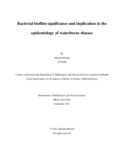| dc.contributor.advisor | Naser, Iftekher Bin | |
| dc.contributor.author | Momin, Marium | |
| dc.date.accessioned | 2021-12-12T05:38:40Z | |
| dc.date.available | 2021-12-12T05:38:40Z | |
| dc.date.copyright | 2021 | |
| dc.date.issued | 2021-09 | |
| dc.identifier.other | ID 19376002 | |
| dc.identifier.uri | http://hdl.handle.net/10361/15719 | |
| dc.description | This thesis report is submitted in partial fulfillment of the requirement for the degree of Master of Science in Biotechnology, 2021. | en_US |
| dc.description | Catalogued from PDF version of thesis. | |
| dc.description | Includes bibliographical references (pages 35-38). | |
| dc.description.abstract | In the epidemiology of WBDOs, assessing the possible risk of biofilm and studying it is crucial. In this study, we look at the epidemiology of waterborne diseases as well as the diseases altogether. WB disease outbreaks are common, and bacterial biofilm is one of the major reasons. The paper also provides a broad overview of the role of bacterial biofilm in the epidemiology of WBDO by providing a general overview of the nature, life cycle, and mechanism of bacterial biofilm, as well as how infectious diseases associated with bacterial biofilm cause waterborne disease outbreaks around the world. Later, the implication of bacterial biofilm in WBDO is highlighted by depicting biofilm formation in the water distribution system. There are numerous nations on the globe today where water shortages, rather than water quality, are the most serious health concern. Access to enough safe drinking water should be considered a basic human right. Bacterial biofilm development in water distribution networks is the underlying cause of WBDOs. To draw a conclusion on the review paper, certain cases of waterborne diseases induced by bacterial biofilm formation were mentioned in the concluding part. One of the objectives of this review is to discuss the vast range of unique issues impacting waterborne diseases in terms of biofilm formation and development, which are often overlooked in the epidemiology of waterborne diseases for disease control. Furthermore, we feel that once the reader understands them better, it becomes more crucial to evaluate the past and recent occurrence of outbreaks and their epidemiology of waterborne diseases. Finally, this study demonstrates that bacterial biofilm is present in many, if not all, chronic infections. This information is vital for the creation of successful WBDO epidemiological initiatives. | en_US |
| dc.description.statementofresponsibility | Marium Momin | |
| dc.format.extent | 38 pages | |
| dc.language.iso | en | en_US |
| dc.publisher | Brac University | en_US |
| dc.rights | Brac University theses are protected by copyright. They may be viewed from this source for any purpose, but reproduction or distribution in any format is prohibited without written permission. | |
| dc.subject | Waterborne disease | en_US |
| dc.subject | Bacterial biofilm | en_US |
| dc.subject | Waterborne disease outbreaks | en_US |
| dc.subject | Drinking water system | en_US |
| dc.subject | Epidemiology | en_US |
| dc.subject.lcsh | Waterborne infection | |
| dc.subject.lcsh | Biofilms. | |
| dc.title | Bacterial biofilm significance and implication in the epidemiology of waterborne disease | en_US |
| dc.type | Thesis | en_US |
| dc.contributor.department | Department of Mathematics and Natural Sciences, Brac University | |
| dc.description.degree | M. Biotechnology | |

